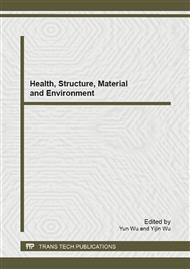[1]
Berstrom.S. G: Conclusion from the Symposium on Concrete at Early Ages. RILEM Bulletin, Pairs, (1982).
Google Scholar
[2]
Geert De Schutter: Applicability of degree of hydration concept and maturity method for thermo-visco-elastic behavior of early age concrete. Cement & Concrete Composites Vol. 26 (2004), p.437–443.
DOI: 10.1016/s0958-9465(03)00067-2
Google Scholar
[3]
Luo Qiling, Xing Feng, Han Xuning , Wang Yu: Simplified method of the weighted maturity in prediction of the early-age compressive strength. Concrete Vol. 5 (2010), pp.39-42. (In Chinese).
Google Scholar
[4]
Duan Zhihua, Yang Xiaoming: Study on the relationship of maturity and the compressive strength of concrete . Water Resources and PowerVol. 27 (2009) , pp.166-168. (In Chinese).
Google Scholar
[5]
Li Faqian: the inprovement of maturity theory . Concrete Vol. 10 (2002), pp.12-14. (In Chinese).
Google Scholar
[6]
Freiesleben HP, Pedersen E J, in: Curing of concrete structures, draft DEB-guide to durable concrete structures, appendix1(1985).
Google Scholar
[7]
Radjy F F, Vunic D W, in: Heat signature testing of concrete. Proceedings of Structural Materials Technology, NDT Conference (1994).
Google Scholar
[8]
Byfors J: in Plain concrete at early ages research, edtied by Swedish Cement &Concrete Research Institute, Stockholm (1980).
Google Scholar
[9]
McCullough B F, Rasmussen R O: Fast track paving: concrete tem-perature control and traffic opening criteria for bonded concrete over-lays. ( Task G Final Report, 1999).
Google Scholar
[10]
Knudsen T: Modeling hydration of portland cement-the effect of parti-cle size distribution. (Characterization and Performance Prediction of Cement and Concrete, 1982).
Google Scholar
[11]
Scanlon J M, McDonald J E: Thermal properties, significance of tests and properties of concrete and concrete-making materials. (ASTM Special Technical Publication, 1994).
DOI: 10.1520/stp36423s
Google Scholar
[12]
Khan A A, Cook W D, Mitchell D. Thermal propertiesandtransi-ent analysis of structural members during hydration. ACI Materials Journal, vol. 3, (1998), pp.293-302.
Google Scholar
[13]
Jieying Zhang, Daniel Cusson, Paulo Monteiro, John Harvey: New perspectives on maturity method and approach for high performance concrete applications concrete Cement & Concrete Composites, (2008) p.1438–1446.
DOI: 10.1016/j.cemconres.2008.08.001
Google Scholar


